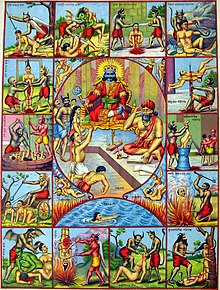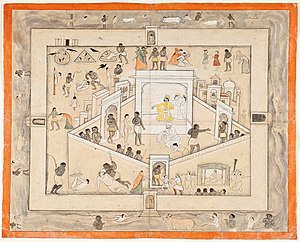Naraka (Hinduism)
[2] The Bhagavata Purana describes Naraka as beneath the earth, similar to the western Hell, between the seven realms of the underworld (Patala) and the Garbhodaka Ocean, the lowest, most southerly region of the universe.
Pitrloka, the "capital" of Naraka headed by Agniṣvāttā, is where our deceased predecessors and relatives (Pitrs) reside, and is also located in this lower region.
People devoted to charity, especially donors of food, and eternal truth speakers are spared the justice of Yama's court.
He also assesses the vices of the dead and accords judgement, assigning them to appropriate hells as punishment commensurate with the severity and nature of their sins.
[3][4] A person is not freed of samsara (the cycle of birth-death-rebirth) and must take birth again after his prescribed pleasure in Svarga or punishment in Naraka is over.
It is also called Saṃyamanī, "where only truth is spoken, and the weak torment the strong", Mṛtyulokāya – the world of Death or of the dead and the "city of the king of ghosts", Pretarājapura.
[8][9][10] The Manu Smriti mentions 21 hells: Tamisra, Andhatamisra, Maharaurava, Raurava, Kalasutra, Mahanaraka, Samjivana, Mahavichi, Tapana, Sampratapana, Samhata, Sakakola, Kudmala, Putimrittika, Lohasanku, Rijisha, Pathana, Vaitarani, Salmali, Asipatravana and Lohadaraka.
[11] The Yajnavalkya Smriti also lists twenty-one: Tamisra, Lohasanku, Mahaniraya, Salamali, Raurava, Kudmala, Putimrittika, Kalasutraka, Sanghata, Lohitoda, Savisha, Sampratapana, Mahanaraka, Kakola, Sanjivana, Mahapatha, Avichi, Andhatamisra, Kumbhipaka, Asipatravana and Tapana.
[3][4][5][13] The Bhagavata Purana enumerates the following 28: Tamisra, Andhatamisra, Raurava, Maharaurava, Kumbhipaka, Kalasutra, Asipatravana, Sukaramukha, Andhakupa, Krimibhojana, Samdamsa, Taptasurmi, Vajrakantaka-salmali, Vaitarani, Puyoda, Pranarodha, Visasana, Lalabhaksa, Sarameyadana, Avichi, Ayahpana, Ksharakardama, Raksogana-bhojana, Sulaprota, Dandasuka, Avata-nirodhana, Paryavartana and Suchimukha.
Taptasurmi, Ayahpana, Raksogana-bhojana, Avata-nirodhana, Paryavartana are replaced by Taptamurti, Apahpana, Raksogana-sambhoja, Avatarodha, Paryavartanataka respectively.
[4] The Vishnu Purana mentions the 28 in the following order: Raurava, Shukara, Rodha, Tala, Visasana, Mahajwala, Taptakumbha, Lavana, Vimohana, Rudhirandha, Vaitaraní, Krimiśa, Krimibhojana, Asipatravana, Krishna, Lalabhaksa, Dáruńa, Púyaváha, Pápa, Vahnijwála, Adhośiras, Sandansa, Kalasutra, Tamas, Avichi, Śwabhojana, Apratisht́ha, and another Avichi.
The Shatapatha Brahmana is the first text to mention the pain and suffering of Naraka in detail, while the Manu Smriti begins naming the multiple hells.
The living beings hurt by such a man take the form of savage serpent-like beasts called rurus and torture this person.
[5] Maharaurava (great-fearful): A person who indulges at the expense of other beings is afflicted with pain by fierce rurus called kravyadas, who eat his flesh.
He is attacked by birds, mammals, reptiles, mosquitoes, lice, worms, flies and others, who deprive him of rest and compel him to run hither and thither.
[5] Puyoda (water of pus): Shudras (workmen-caste) and husbands or sexual partners of lowly women and prostitutes – who live like beasts devoid of cleanliness and good behaviour – fall in Puyoda, the ocean of pus, excreta, urine, mucus, saliva and other repugnant things.
[3][4] Pranarodha (obstruction to life): Some Brahmins, Kshatriyas and Vaishyas (merchant caste) indulge in the sport of hunting with their dogs and donkeys in the forest, resulting in wanton killing of beasts.
[3][4] The Vishnu Purana disagrees stating that one who eats before offering food to the gods, the ancestors or guests is brought to this hell.
Seven hundred and twenty ferocious dogs, the sons of Sarama, with razor-sharp teeth, prey on them at the behest of Yamadutas.
[3][4] Avici/Avicimat (waterless/waveless): A person, who lies on oath or in business, is repeatedly thrown head-first from a 100 yojana high mountain whose sides are stone waves, but without water.
[3][4] Ksarakardama (acidic/saline mud/filth): One who in false pride, does not honour a person higher than him by birth, austerity, knowledge, behaviour, caste or spiritual order, is tortured in this hell.
[3][4] Shulaprota (pierced by sharp pointed spear/dart): Some people give shelter to birds or animals pretending to be their saviours, but then harass them poking with threads, needles or using them like lifeless toys.
Rudhirándha (wells of blood): Wrestlers or boxers who commit violence for entertainment, fishermen, followers of bastards, arsonists, poisoners, informants, fortune-tellers, traitors, those who have coitus on sacred taboo days and those who live off their wives' prostitution are cast here.
Shwabhojana (food of dogs): A religious student who sleeps in the day and one who does not have spiritual knowledge and learns it from children are damned here.
The Hindu religion regards Hell not as a place of lasting permanence, but as an alternate domain from which an individual can return to the present world after crimes in the previous life have been compensated for.
The concept of Hell has provided many different opportunities for the Hindu religion including narrative, social and economic functions.
This journey creates a scene for the audience that helps illustrate the importance of understanding hell as well as heaven before accepting either extreme.
This narrative utilizes the Hindu religion in order to teach lessons on tolerance and acceptance of one another's faults as well as virtues.
A large portion of it is designed to help people of the Hindu faith understand evil deeds (pātaka) and their karmic consequences in various hellish rebirths.
An opposite social facet to these hellish rebirths is the precise way in which a person can redeem himself/herself from a particular crime through a series of vows (such as fasting, water purification rituals, chanting, and even sacrifices).



